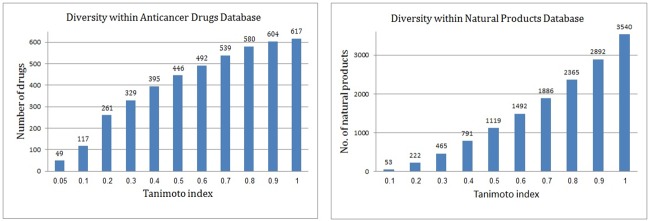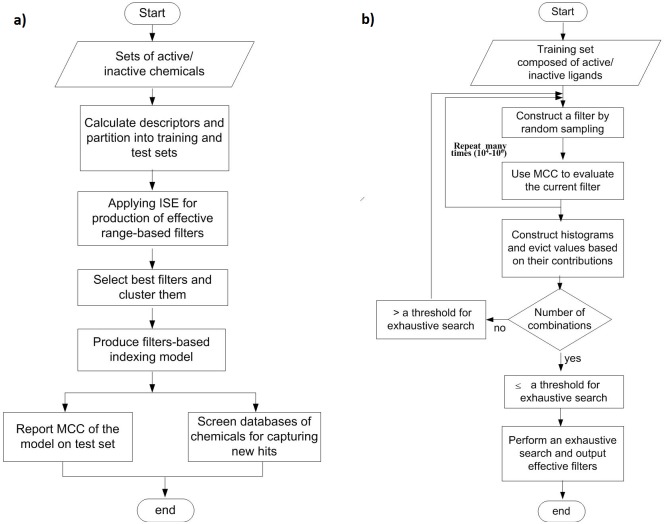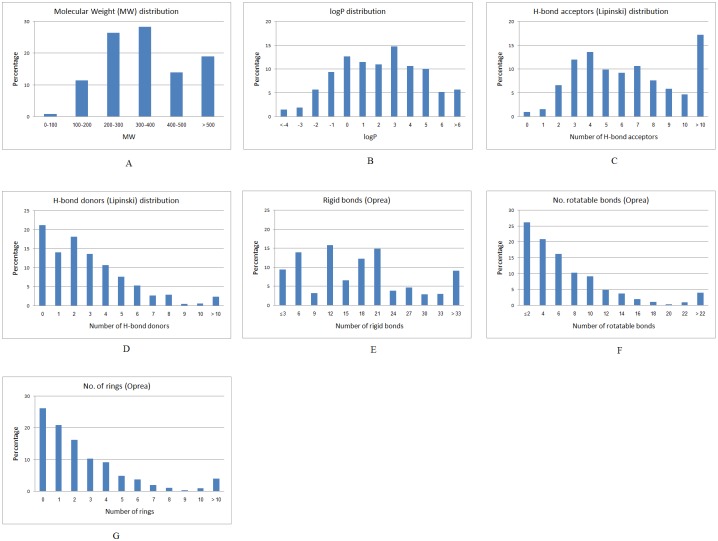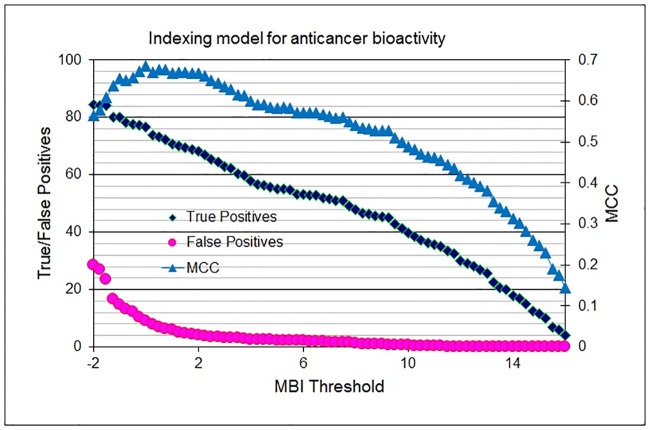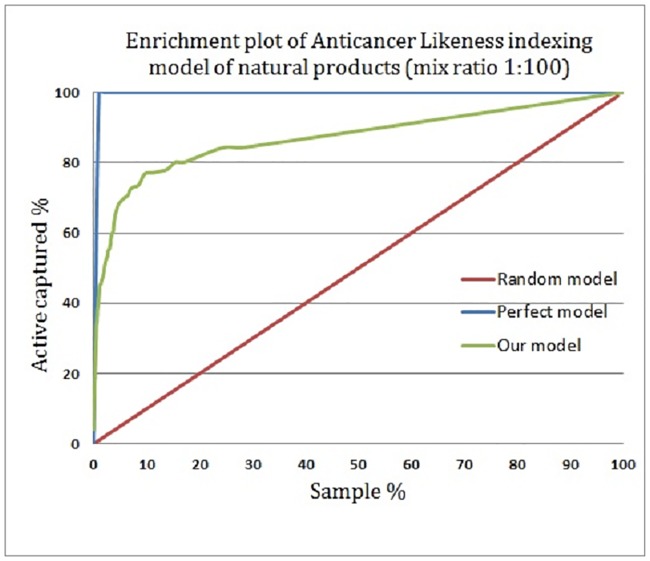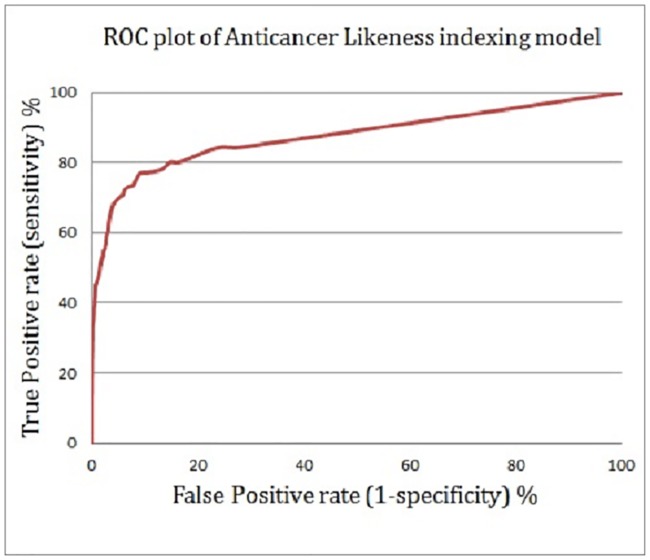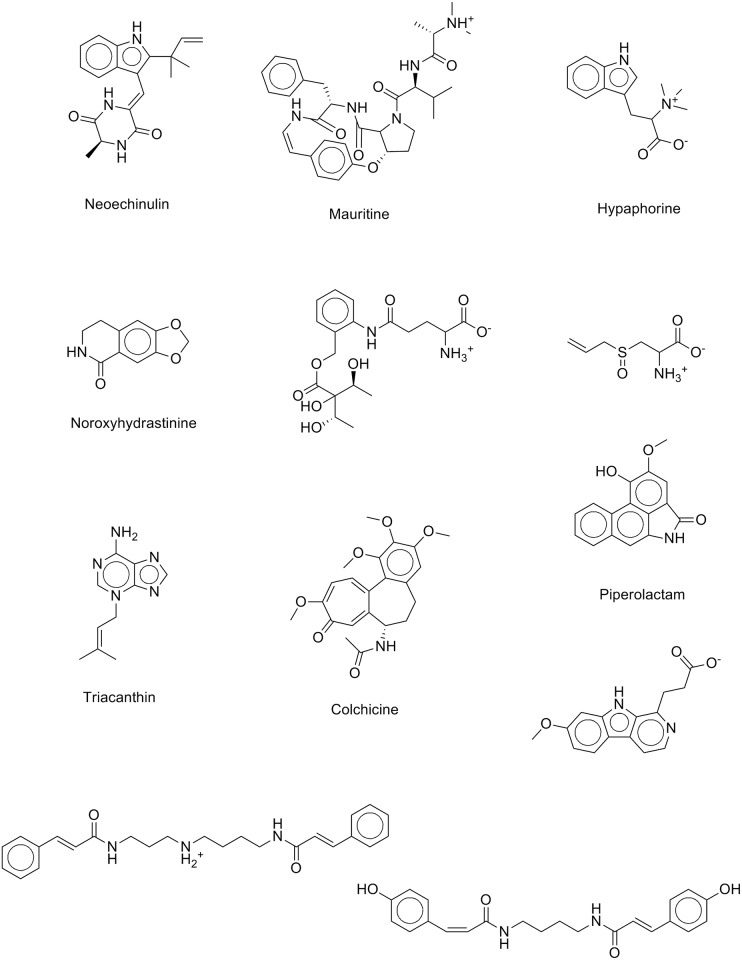Abstract
Cancer is considered one of the primary diseases that cause morbidity and mortality in millions of people worldwide and due to its prevalence, there is undoubtedly an unmet need to discover novel anticancer drugs. However, the traditional process of drug discovery and development is lengthy and expensive, so the application of in silico techniques and optimization algorithms in drug discovery projects can provide a solution, saving time and costs. A set of 617 approved anticancer drugs, constituting the active domain, and a set of 2,892 natural products, constituting the inactive domain, were employed to build predictive models and to index natural products for their anticancer bioactivity. Using the iterative stochastic elimination optimization technique, we obtained a highly discriminative and robust model, with an area under the curve of 0.95. Twelve natural products that scored highly as potential anticancer drug candidates are disclosed. Searching the scientific literature revealed that few of those molecules (Neoechinulin, Colchicine, and Piperolactam) have already been experimentally screened for their anticancer activity and found active. The other phytochemicals await evaluation for their anticancerous activity in wet lab.
Introduction
Cancer is one of the primary global diseases that cause morbidity and mortality in millions of people worldwide [1]. Its incidence is expected to rise by about 70% over the next two decades. Cancer cells can initiate, spread, lodge, and grow in various tissues and organs throughout the body, where the five most common sites of cancer among men are in the lungs, prostate, colorectum, stomach, and liver, and among women in the breast, colorectum, lungs, cervix, and stomach [2]. Current cancer therapies often involve surgical removal and radiation treatment of the large accumulated biomass of cancer, typically followed by systemic chemotherapy treatment used for maintenance treatment. The major disadvantages of chemotherapy are the recurrence of cancer, associated with drug resistance, and severe side effects that can limit the use of anticancer drugs and thus impair patients’ quality of life. Despite this, chemotherapy is still one of the most widely used treatments in all kinds of cancers and at every stage of cancer progression.
The molecular basis of cancer cell development among differentiated normal cells is well studied and has been attributed to two key components, namely oncogenes and tumor suppressor genes [3, 4]. Respective activation and inactivation of these oncogenes and tumor suppressor genes by naturally occurring mutations in either one or both of them can trigger uncontrolled growth and proliferation ending with transformation of cells acquiring carcinogenesis properties [4–7]. Similarly, the inactivation of tumor suppressor genes can result in uncontrolled cell growth [6]. An understanding of the molecular mechanisms underlying cancer progression has led to the development of a vast number of anticancer drugs; however, the use of many chemically synthesized anticancer drugs has caused considerable harm to patients, mainly in the form of immune system suppression. Therefore, the discovery and development of new drugs based on natural products have been the focus of much research [8, 9]. Alkaloids, flavonoids, terpenoids, polysaccharides, saponins and others have been documented as natural bioactive products with potent anticancer activity [10–12]. Most (> 60%) anticancer drugs that are in clinical use and have demonstrated significant efficacy for combatting cancer originate from natural products derived from plants, marine organisms, and microorganisms [13]. The anticancer activity of most natural products often act via regulating immune function, inducing apoptosis or autophagy, or inhibiting cell proliferation.
Nature is the best source of drugs[14, 15] and due to our interest in the identification of new anticancer natural products that overcome the limitations of cell toxicity and adverse reactions, in addition to exhibiting improvements in treatment efficiency, we describe here in silico model for indexing natural products for their anticancer bioactivity. The in silico studies and mathematical-/statistical-based modeling presented here provide insights into the physicochemical properties associated with anticancer activity at the molecular level. Structural based [16–18] and/or Ligand-based techniques [19, 20] are widely used for constructing predictive models and for the in silico screening of large chemical databases, whose aim is to detect novel bioactive ligands [21, 22]. Models for constructing predictive models and separating active from inactive ligands can be developed by selecting sets of active and inactive chemicals for learning purposes and using certain optimization methods (such as neural networks [23], genetic algorithms [24], support vector machines [25], the k-nearest neighbor algorithm, [26, 27], or some combination thereof [27–29]). Modelers presume that chemicals with certain biological properties have common features that are responsible for their bioactivity, but these cannot be easily recognized if an inadequate number of bioactive ligands are tested. To arrive at more significant and robust conclusions, we need to consider large and diverse sets of active/ inactive ligands. As well, the way we select the set of inactive ligands to be used for modeling purposes is highly significant. It should cover the same range of properties possessed by the ligands in the screened database.
The iterative stochastic elimination (ISE) optimization technique is a recent development that has been presented in several research publications[19, 20, 22, 30, 31]. It is an efficient technique for searching a multi-dimensional space in order to identify the best set of solutions (termed global minima and local minima). ISE has been used to solve problems such as proton positioning in proteins [32], the prediction of side-chain conformations [33], the verification of loop conformations [34], and the conformational space of cyclic peptides [35]. During the last few years, ISE has been applied to solving several chemoinformatics problems [22]; certain sets of physicochemical properties are selected from a large set of physicochemical properties, and the ranges of the selected properties are optimized to produce the best set of solutions (termed filters) capable of separating active from inactive ligands. The constructed filters are jointly applied to index ligands for their bioactivity and to rank and prioritize molecules in large chemical databases [20, 30, 36].
In this paper, we disclose a novel model for indexing natural products for their potential anticancer activity, and map the discriminative physicochemical properties of 617 FDA-approved anticancer drugs through careful analysis of the composition of filters that were produced by ISE for indexing purposes.
Methods
To construct the predictive model, we used a set of 617 anticancer drugs to constitute the active domain (all anticancer drugs are presented in SMILES format followed by their common names in the supporting information S1 Table). This set of drugs was assembled from CMC (Comprehensive Medicinal Chemistry) database and NCI Drug Dictionary. Another set of 2,892 natural products was used to constitute the inactive domain. This database of natural products was prepared by collecting phytochemicals that were isolated from more than eight hundred diverse plants spread worldwide and are deliverable from AnalytiCon Discovery (www.ac-discovery.com). To obtain the data set of natural products, go to the link https://ac-discovery.com/downloads/ and download "Purified Natural Products". At the first time, each new user need to register and then sign in for file download. We believed that a very small fraction of the 2,892 natural products that were assigned as inactive were actually active ligands. However, from our experience in previous projects, such assignment was justified and beneficial, since (1) the model used for virtual screening should cover the same range of properties as those possessed by the chemicals in the screened database (the natural products database used herein was prepared by collecting phytochemicals isolated from plants, and (2) the effect on model quality is minor if the portion of really false negatives in the training set is less than 1–2%. The Tanimoto index-based diversities within both databases (anticancer drugs and natural products) are shown in Fig 1.
Fig 1. Diversity within anticancer drugs (A, left side) and diversity within natural products database (B, right side).
The physicochemical properties (descriptors) of all the ligands in both databases (the active/anticancer drug and inactive/natural product DBs) were calculated using Molecular Operating Environment (MOE) software, version 2009.10, [http://www.chemcomp.com]. The calculated 1-dimensional (1D)/2-dimensional (2D) descriptors were of physicochemical properties such as molecular weight, log P, H-bond acceptors/donors, solubility, total charge and charge distribution, the types and numbers of atoms, etc. (http://www.chemcomp.com/journal/descr.htm). An assessment of the constructed models and validation of their predictability was done by splitting the datasets of the active/inactive ligands into 66.7% for training and 33.3% for testing. Both training and test sets were generated by an in-house random picking module.
The ISE algorithm was utilized to build a prediction model capable of indexing natural products for potential anticancer activity. According to our algorithm [20], the optimal model capable of differentiating between active and inactive ligands was obtained by searching multivariable space for the best sets of descriptors (termed variables) and the best range of each descriptor that separated the active from inactive ligands. The optimization process was highly complicated, since the physicochemical properties of the ligands interact with each other, and changes in the range of one property may affect the best range of other properties that compose the same filter. The optimization process must consider all of the properties of the filter at the same time. Fig 2 summarizes the main points of the ISE-based modeling process. More details on the utility of ISE for extracting the best sets of descriptors, as well as the best ranges, from a certain set of descriptors can be found in our previously reported studies [20, 30].
Fig 2. Flowcharts for the modeling process (2a), and the ISE engine (2b).
Results and discussion
The ISE algorithm was applied to construct an in silico prediction system for detecting natural products with potential anticancer activity. This study was based on a set of 617 anticancer drugs labeled as active chemicals and 2,892 natural products labeled as inactive phytochemicals. It is worth noting that a few of the 2,892 natural products had the potential to be anticancer compounds, but the effect of that assumption on the quality of the prediction model was negligible, especially since the fraction of active products was expected to be less than 1–2% (data not shown). From previous projects, we learned that predictive models for virtual screening purposes should cover the same range of properties as those possessed by the objects in the screened database. In light of that, we selected, as the inactive set, chemicals with the same "property range" as the chemicals in the screened database. As well, in order to make sure that our active set of chemicals would not be biased by having similar structures, we checked the structural diversity within the 617 anticancer drugs and the 2,892 natural products and found that both databases were highly diverse. 86 of the anticancer drugs and 53 of the natural products had a Tanimoto index of similarity < 0.7. As shown in Fig 3, it is interesting to note that 83% of the anticancer drugs obeyed Lipinski’s Rule of Five (ROF), and 68% obeyed the Oprea rules for lead-likeness [37]. Fig 4 presents distribution plots of the Lipinski and Oprea physicochemical properties of the set of anticancer drugs.
Fig 3. Physicochemical properties distribution of anticancer drugs (A) Molecular weight distribution, (B) Log P values, (C) Number of H-bond acceptors [lip_acc], (D) Number of H-bond donors [lip_don], (E) Number of rigid bonds, (F) number of rotatable bonds, (G) Number of aromatic atoms.
Fig 4. Violation distribution of anticancer drugs to Lipinski rule of 5 for drug-likeness (left side) and Oprea rule for lead-likeness (right side).
The indexing model was produced by 29 unique filters, which consisted of different sets of descriptors and/or same set of descriptors with different ranges. Table 1 presents three of the filters as an example. The Matthews correlation coefficients (MCCs) of the different filters are very close, but they differ in their true positive percentage and true negative percentage. Filter number 1, presented in Table 1, has a MCC of 0.568, and with this filter, 53.7% of the anticancer drugs were successfully identified as true positives, while only ~2.5% of the natural products database were classified as active. The filter is composed of ranges of four descriptors. Each molecule that fall within these ranges is considered active; while molecules having as least one descriptor that fall outside the range is considered inactive. It is worth stating that we presumed that most of the screened natural products were inactive, and thus, this classification is considered a false positive, although we are aware that some of those natural products were active and were correctly classified by our proposed prediction model.
Table 1. Three filters out of the 29 filters used for producing the anticancer indexing model.
The Matthews correlation coefficients (MCCs), the true positive (TP) percentages, the true negative (TN) percentages, and the descriptors' ranges are shown.
| Filter 1 | Filter 2 | Filter 3 |
|---|---|---|
| MCC = 0.568 | MCC = 0.554 | MCC = 0.551 |
| TP = 53.64% | TP = 63.37% | TP = 50.57% |
| TN = 97.48% | TN = 90.04% | TN = 97.99% |
| GCUT_SLOGP_0 (-2.28−-0.89) | a_ICM (1.47–2.21) | chiral_u (0.– 2.0) |
| BCUT_SLOGP_3 (-0002. - 2.97) | PEOE_VSA-5 (0. - 393.44) | b_rotR (0. - 0.80) |
| vsa_don (0.24–247.82) | PEOE_VSA_FPNEG (0. - 0.516) | vsa_don (0.24–247.82) |
| PEOE_VSA+0 (0. - 672.01) | PEOE_VSA+4 (0. - 51.58) | b_1rotR (0. - 0.80) |
The composition of the output list of best discriminative filters was analyzed. Table 2 lists the most redundant descriptors of the 29 filters used to produce the anticancer indexing model. The third column reports how many more times each descriptor was redundant rather than random. Fig 5 was built using the WORDLE module; it displays the redundancy of the descriptors in graphical mode.
Table 2. Descriptors' redundancy.
| Descriptor name | Redundancy | Redundant more times than random |
|---|---|---|
| GCUT_SLOGP_0 | 15 | 24.1 |
| a_ICM | 10 | 16.0 |
| PEOE_VSA+4 | 7 | 11.2 |
| SMR_VSA1 | 5 | 8.0 |
| logS | 5 | 8.0 |
| Nmol | 5 | 8.0 |
| lip_druglike | 4 | 6.4 |
| chi1_C | 4 | 6.4 |
Fig 5. Redundancy of descriptors in the 29 filters used to produce the anticancer indexing model.
The picture was constructed by using WORDLE module.
The efficiency of the anticancer activity-indexing model, which was produced by the 29 range-based filters, is displayed in Fig 6. The true/false positive percentage (left y-axis) and Matthews's correlation coefficients (right y-axis) are plotted against the molecular bioactivity index thresholds (x-axis).
Fig 6. Indexing model for anticancer potential activity: True/false positives percentage (left Y-axis) and Matthews's correlation coefficient (MCC, right Y-axis) illustrated against molecular bioactivity index threshold (MBI, X-axis).
Figs 7 and 8 show the enrichment plot and the receiver operating characteristic (ROC) plot of the suggested anticancer bioactivity-indexing model, respectively. The enrichment plot (Fig 7) illustrates how the anticancer drug candidates could be predicted if natural products are ranked according to their scores as predicted by the ISE-based model, rather than based on random selection. An enrichment plot where the ISE-based model overlaid with the perfect model at the one percent highest fraction indicates the high prioritization power of the constructed model. By applying this proposed anticancer bioactivity indexing model at a mix ratio of 1:100 (active/ inactive), 42% of the anticancer drugs could be captured in the top one percent of the screened compounds, compared with 100% in the perfect model and 1% in the random model.
Fig 7. Enrichment plot of the anticancer potential activity-indexing model of natural products.
Fig 8. A receiver operating characteristic (ROC) curve showing the performance of the anticancer bioactivity-indexing model.
The attained area under the curve (AUC) of the proposed ISE-based model is 0.95, indicating the effectiveness of the model. As well, the ISE-based model and the perfect model overlap somewhere in the range of molecular bioactivity index (MBI) ≥ 4.0; thus, the model is considered highly discriminative and effective for classifying anticancer drug candidates and inactive natural products. Fig 9 shows twelve natural products that were highly indexed as potential anticancer drug candidates by our ISE-based anticancer indexing model. Searching the scientific literature revealed that few of those molecules (Neoechinulin[38], Colchicine[39], and Piperolactam[40]) have already been experimentally screened for their anticancer activity and found active. The other phytochemicals await evaluation for their anticancerous activity in wet lab.
Fig 9. Twelve of the natural products that are scored highly as potential anticancer drug candidates according to our ISE-based anticancer indexing model.
Conclusions
A highly efficient and robust model for indexing natural products for their anticancer bioactivity has been built using the ISE algorithm. We believe that the use of such an in silico model to screen large databases of natural products could undoubtedly save time and costs and aid in detecting novel natural-based anticancer drug candidates. We have disclosed some highly indexed phytochemicals that could serve as potential anticancer drug candidates. A literature search shows that few of those molecules have already been experimentally screened for their anti-cancerous activity and found active. The other phytochemicals await evaluation for their anti-cancerous activity in wet lab. As well, this study provides important insights into discriminative properties of natural products having anti-cancerous activity.
Supporting information
(PDF)
Acknowledgments
We acknowledge RAND Biotechnologies LTD for helping in construction of the drugs' database.
Abbreviations
- EF
enrichment factor
- FP
false positive
- ISE
iterative stochastic elimination
- MBI
molecular bioactivity index
- MCC
Matthews’ correlation coefficient
- MD
molecular dynamics
- TP
true positive
- vHTS
virtual high-throughput screening
Data Availability
A set of 617 anticancer drugs is available in a supporting information file (Table S1). A set of natural products can be downloaded from www.ac-discovery.com. To obtain the data set of natural products, go to the link https://ac-discovery.com/downloads/ and download "Purified Natural Products".
Funding Statement
This work was funded by an unrestricted research grants from Al-Qasemi Academic College and the Ministry of Science, Space and Technology. The funder had no role in study design, data collection and analysis, decision to publish, or preparation of the manuscript.
References
- 1.Lozano R, Naghavi M, Foreman K, Lim S, Shibuya K, Aboyans V, et al. Global and regional mortality from 235 causes of death for 20 age groups in 1990 and 2010: a systematic analysis for the Global Burden of Disease Study 2010. Lancet. 2012;380(9859):2095–128. doi: 10.1016/S0140-6736(12)61728-0 . [DOI] [PMC free article] [PubMed] [Google Scholar]
- 2.Torre LA, Bray F, Siegel RL, Ferlay J, Lortet-Tieulent J, Jemal A. Global cancer statistics, 2012. CA Cancer J Clin. 2015;65(2):87–108. doi: 10.3322/caac.21262 . [DOI] [PubMed] [Google Scholar]
- 3.Levine AJ, Puzio-Kuter AM. The control of the metabolic switch in cancers by oncogenes and tumor suppressor genes. Science. 2010;330(6009):1340–4. doi: 10.1126/science.1193494 . [DOI] [PubMed] [Google Scholar]
- 4.Ngo DC, Ververis K, Tortorella SM, Karagiannis TC. Introduction to the molecular basis of cancer metabolism and the Warburg effect. Mol Biol Rep. 2015;42(4):819–23. doi: 10.1007/s11033-015-3857-y . [DOI] [PubMed] [Google Scholar]
- 5.Vander Heiden MG, Cantley LC, Thompson CB. Understanding the Warburg effect: the metabolic requirements of cell proliferation. Science. 2009;324(5930):1029–33. doi: 10.1126/science.1160809 . [DOI] [PMC free article] [PubMed] [Google Scholar]
- 6.Ward PS, Thompson CB. Metabolic reprogramming: a cancer hallmark even warburg did not anticipate. Cancer Cell. 2012;21(3):297–308. doi: 10.1016/j.ccr.2012.02.014 . [DOI] [PMC free article] [PubMed] [Google Scholar]
- 7.Jones RG, Thompson CB. Tumor suppressors and cell metabolism: a recipe for cancer growth. Genes Dev. 2009;23(5):537–48. doi: 10.1101/gad.1756509 . [DOI] [PMC free article] [PubMed] [Google Scholar]
- 8.Wright GD. Opportunities for natural products in 21st century antibiotic discovery. Nat Prod Rep. 2017;34(7):694–701. doi: 10.1039/c7np00019g . [DOI] [PubMed] [Google Scholar]
- 9.Yao H, Liu J, Xu S, Zhu Z, Xu J. The structural modification of natural products for novel drug discovery. Expert Opin Drug Discov. 2017;12(2):121–40. doi: 10.1080/17460441.2016.1272757 . [DOI] [PubMed] [Google Scholar]
- 10.Avato P, Migoni D, Argentieri M, Tava A, Fanizzi FP. Activity of saponins from Medicago species against HeLa and MCF-7 cell lines and their capacity to potentiate cisplatin effect. Anticancer Agents Med Chem. 2017. doi: 10.2174/1871520617666170727152805 . [DOI] [PubMed] [Google Scholar]
- 11.Joshi P, Vishwakarma RA, Bharate SB. Natural alkaloids as P-gp inhibitors for multidrug resistance reversal in cancer. Eur J Med Chem. 2017;138:273–92. doi: 10.1016/j.ejmech.2017.06.047 . [DOI] [PubMed] [Google Scholar]
- 12.Majumder D, Das A, Saha C. Catalase inhibition an anti cancer property of flavonoids: A kinetic and structural evaluation. Int J Biol Macromol. 2017;104(Pt A):929–35. doi: 10.1016/j.ijbiomac.2017.06.100 . [DOI] [PubMed] [Google Scholar]
- 13.Seelinger M, Popescu R, Giessrigl B, Jarukamjorn K, Unger C, Wallnofer B, et al. Methanol extract of the ethnopharmaceutical remedy Smilax spinosa exhibits anti-neoplastic activity. Int J Oncol. 2012;41(3):1164–72. doi: 10.3892/ijo.2012.1538 . [DOI] [PubMed] [Google Scholar]
- 14.Frank A, Abu-Lafi S, Adawi A, Schwed JS, Stark H, Rayan A. From medicinal plant extracts to defined chemical compounds targeting the histamine H4 receptor: Curcuma longa in the treatment of inflammation. Inflamm Res. 2017. doi: 10.1007/s00011-017-1075-x . [DOI] [PubMed] [Google Scholar]
- 15.Kacergius T, Abu-Lafi S, Kirkliauskiene A, Gabe V, Adawi A, Rayan M, et al. Inhibitory capacity of Rhus coriaria L. extract and its major component methyl gallate on Streptococcus mutans biofilm formation by optical profilometry: Potential applications for oral health. Mol Med Rep. 2017;16(1):949–56. doi: 10.3892/mmr.2017.6674 . [DOI] [PubMed] [Google Scholar]
- 16.Zaid H, Raiyn J, Osman M, Falah M, Srouji S, Rayan A. In silico modeling techniques for predicting the tertiary structure of human H4 receptor. Front Biosci (Landmark Ed). 2016;21:597–619. . [DOI] [PubMed] [Google Scholar]
- 17.Shahaf N, Pappalardo M, Basile L, Guccione S, Rayan A. How to Choose the Suitable Template for Homology Modelling of GPCRs: 5-HT7 Receptor as a Test Case. Mol Inform. 2016;35(8–9):414–23. doi: 10.1002/minf.201501029 . [DOI] [PubMed] [Google Scholar]
- 18.Pappalardo M, Rayan M, Abu-Lafi S, Leonardi ME, Milardi D, Guccione S, et al. Homology-based Modeling of Rhodopsin-like Family Members in the Inactive State: Structural Analysis and Deduction of Tips for Modeling and Optimization. Mol Inform. 2017;36(8). doi: 10.1002/minf.201700014 . [DOI] [PubMed] [Google Scholar]
- 19.Cern A, Marcus D, Tropsha A, Barenholz Y, Goldblum A. New drug candidates for liposomal delivery identified by computer modeling of liposomes' remote loading and leakage. J Control Release. 2017;252:18–27. doi: 10.1016/j.jconrel.2017.02.015 . [DOI] [PubMed] [Google Scholar]
- 20.Rayan A, Marcus D, Goldblum A. Predicting oral druglikeness by iterative stochastic elimination. J Chem Inf Model. 2010;50(3):437–45. Epub 2010/02/23. doi: 10.1021/ci9004354 . [DOI] [PubMed] [Google Scholar]
- 21.Zatsepin M, Mattes A, Rupp S, Finkelmeier D, Basu A, Burger-Kentischer A, et al. Computational Discovery and Experimental Confirmation of TLR9 Receptor Antagonist Leads. J Chem Inf Model. 2016;56(9):1835–46. doi: 10.1021/acs.jcim.6b00070 . [DOI] [PubMed] [Google Scholar]
- 22.Pappalardo M, Shachaf N, Basile L, Milardi D, Zeidan M, Raiyn J, et al. Sequential application of ligand and structure based modeling approaches to index chemicals for their hH4R antagonism. PLoS One. 2014;9(10):e109340 doi: 10.1371/journal.pone.0109340 . [DOI] [PMC free article] [PubMed] [Google Scholar]
- 23.Lusci A, Pollastri G, Baldi P. Deep architectures and deep learning in chemoinformatics: the prediction of aqueous solubility for drug-like molecules. J Chem Inf Model. 2013;53(7):1563–75. Epub 2013/06/26. doi: 10.1021/ci400187y . [DOI] [PMC free article] [PubMed] [Google Scholar]
- 24.Zaheer-ul H, Uddin R, Yuan H, Petukhov PA, Choudhary MI, Madura JD. Receptor-based modeling and 3D-QSAR for a quantitative production of the butyrylcholinesterase inhibitors based on genetic algorithm. J Chem Inf Model. 2008;48(5):1092–103. doi: 10.1021/ci8000056 . [DOI] [PubMed] [Google Scholar]
- 25.Heikamp K, Bajorath J. Comparison of confirmed inactive and randomly selected compounds as negative training examples in support vector machine-based virtual screening. J Chem Inf Model. 2013;53(7):1595–601. Epub 2013/06/27. doi: 10.1021/ci4002712 . [DOI] [PubMed] [Google Scholar]
- 26.Shen M, Beguin C, Golbraikh A, Stables JP, Kohn H, Tropsha A. Application of predictive QSAR models to database mining: identification and experimental validation of novel anticonvulsant compounds. J Med Chem. 2004;47(9):2356–64. doi: 10.1021/jm030584q . [DOI] [PubMed] [Google Scholar]
- 27.Rayan A, Falah M, Mawasi H, Raiyn N. Assessing drugs for their cardio-toxicity. Letters in Drug Design & Discovery. 2010;7(6):409–14. [Google Scholar]
- 28.Deeb O, Jawabreh S, Goodarzi M. Exploring QSARs of vascular endothelial growth factor receptor-2 (VEGFR-2) tyrosine kinase inhibitors by MLR, PLS and PC-ANN. Curr Pharm Des. 2013;19(12):2237–44. Epub 2012/09/29. . [DOI] [PubMed] [Google Scholar]
- 29.Mussa HY, Hawizy L, Nigsch F, Glen RC. Classifying large chemical data sets: using a regularized potential function method. J Chem Inf Model. 2011;51(1):4–14. Epub 2010/12/16. doi: 10.1021/ci100022u . [DOI] [PubMed] [Google Scholar]
- 30.Rayan A, Falah M, Raiyn J, Da'adoosh B, Kadan S, Zaid H, et al. Indexing molecules for their hERG liability. Eur J Med Chem. 2013;65:304–14. doi: 10.1016/j.ejmech.2013.04.059 . [DOI] [PubMed] [Google Scholar]
- 31.Aswad M, Rayan M, Abu-Lafi S, Falah M, Raiyn J, Abdallah Z, et al. Nature is the best source of anti-inflammatory drugs: indexing natural products for their anti-inflammatory bioactivity. Inflamm Res. 2017. doi: 10.1007/s00011-017-1096-5 . [DOI] [PubMed] [Google Scholar]
- 32.Glick M, Goldblum A. A novel energy-based stochastic method for positioning polar protons in protein structures from X-rays. Proteins. 2000;38(3):273–87. Epub 2000/03/14. doi: 10.1002/(SICI)1097-0134(20000215)38:3<273::AID-PROT4>3.0.CO;2-I . [DOI] [PubMed] [Google Scholar]
- 33.Glick M, Rayan A, Goldblum A. A stochastic algorithm for global optimization and for best populations: a test case of side chains in proteins. Proc Natl Acad Sci U S A. 2002;99(2):703–8. Epub 2002/01/17. doi: 10.1073/pnas.022418199 . [DOI] [PMC free article] [PubMed] [Google Scholar]
- 34.Michaeli A, Rayan A. Modeling Ensembles of Loop Conformations by Iterative Stochastic Elimination. Letters in Drug Design & Discovery. 2016;13(3):1–6. [Google Scholar]
- 35.Rayan A, Senderowitz H, Goldblum A. Exploring the conformational space of cyclic peptides by a stochastic search method. J Mol Graph Model. 2004;22(5):319–33. doi: 10.1016/j.jmgm.2003.12.012 . [DOI] [PubMed] [Google Scholar]
- 36.Zeidan M, Rayan M, Zeidan N, Falah M, Rayan A. Indexing Natural Products for Their Potential Anti-Diabetic Activity: Filtering and Mapping Discriminative Physicochemical Properties. Molecules. 2017;22(9). doi: 10.3390/molecules22091563 . [DOI] [PMC free article] [PubMed] [Google Scholar]
- 37.Hann MM, Oprea TI. Pursuing the leadlikeness concept in pharmaceutical research. Curr Opin Chem Biol. 2004;8(3):255–63. doi: 10.1016/j.cbpa.2004.04.003 . [DOI] [PubMed] [Google Scholar]
- 38.Kuramochi K. Synthetic and structure-activity relationship studies on bioactive natural products. Biosci Biotechnol Biochem. 2013;77(3):446–54. doi: 10.1271/bbb.120884 . [DOI] [PubMed] [Google Scholar]
- 39.Kumar A, Sharma PR, Mondhe DM. Potential anticancer role of colchicine-based derivatives: an overview. Anticancer Drugs. 2017;28(3):250–62. doi: 10.1097/CAD.0000000000000464 . [DOI] [PubMed] [Google Scholar]
- 40.Choi YL, Kim JK, Choi SU, Min YK, Bae MA, Kim BT, et al. Synthesis of aristolactam analogues and evaluation of their antitumor activity. Bioorg Med Chem Lett. 2009;19(11):3036–40. doi: 10.1016/j.bmcl.2009.04.020 . [DOI] [PubMed] [Google Scholar]
Associated Data
This section collects any data citations, data availability statements, or supplementary materials included in this article.
Supplementary Materials
(PDF)
Data Availability Statement
A set of 617 anticancer drugs is available in a supporting information file (Table S1). A set of natural products can be downloaded from www.ac-discovery.com. To obtain the data set of natural products, go to the link https://ac-discovery.com/downloads/ and download "Purified Natural Products".



